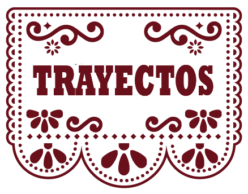Subject pronouns and the present tense of the verb ser: Uso y forma
 ¿Quién es Marlenie? (Who is Marlenie?)
¿Quién es Marlenie? (Who is Marlenie?)
Marlenie is a university student in Texas. Here she introduces herself and her favorite building on campus.
¡Hola! Yo soy Marlenie. Yo soy tu guía (your guide). Yo soy tu compañera en la clase de español. Este es el edificio (building) académico.
In this introduction, Marlenie uses the verb ser in the first person to talk about herself. A verb is a word that describes an action (e.g., write, eat, etc.) or a state of being (e.g., feel, is, etc.). In Spanish, verbs have different forms, conjugaciones (conjugations), depending on who or what is doing an action, which are called the subjects of the verb. A subject can be expressed through a noun (a person, animal, or thing; e.g., Sean, Marlenie, the dog, the car, etc.) or a pronoun (e.g., I, he, they, etc.). The pronouns that indicate who is doing an action are called subject pronouns. Subject pronouns in Spanish are both similar to and different from English. For example, like in English, subject pronouns have singular and plural forms, but, unlike English, some of the pronouns have gender (feminine and masculine). Have a look at this table and compare subject pronouns in both languages. What other similarities/differences do you notice?
| Number | Subject pronouns in Spanish | Subject pronouns in English |
| Singular | yo | I |
| tú | you (informal) | |
| vos | you (informal). Used predominantly in Argentina and Uruguay, but also in other South and Central American countries. More information. | |
| usted/Ud. | you (formal) | |
| él/ella | he/she | |
| Plural | nosotros (masc.)/nosotras (fem.) | we |
| vosotros (masc.)/vosotras (fem.) | you (plural; informal–only used in Spain) | |
| ustedes/Uds. | you (plural: Both informal and formal in Latin America; formal in Spain) | |
| ellos (masc.)/ellas (fem.) | they |
One important difference between Spanish and English is that, while subject pronouns are obligatory in English, they are not needed in Spanish unless there is confusion with respect to who is doing the action, or you want to emphasize the subject. Why do you think this is the case? Have a look at the next table. Pay attention to the different conjugaciones (conjugations) of ser. What do you notice?
| Number | Subject pronoun | Forms of “ser” | |
| Singular | yo | soy | I am |
| tú | eres | you are (informal) | |
| vos | sos | you are (informal). Used predominantly in Argentina and Uruguay, but also in other South and Central American countries. More information. | |
| usted/Ud. | es | you are (formal) | |
| él/ella | es | he/she is | |
| Plural | nosotros (masc.)/nosotras (fem.) | Somos | we are |
| vosotros (masc.)/vosotras (fem.) | sois | you are (plural; informal–only used in Spain) | |
| ustedes/Uds. | son | you are (plural: Both informal and formal in Latin America; formal in Spain) | |
| ellos (masc.)/ellas (fem.) | son | they are | |
You can use these forms of the verb ser (to be) to introduce and describe yourself (what you are like, where you are from) and others, and also to describe things/animals/places. For example, when Marlenie talks about her friends, she says:
Efraín es carismático y activo. (Él) es de Killeen, Tejas.
Ellas son Bailey y Carolina. (Ellas) son responsables y estudiosas.
If you want to use ser in a negative sentence, it is super easy! Just place the word no before the conjugated verb:
Efraín no es carismático y activo.
Bailey y Carolina no son responsables.
Sugerencia: If you want to learn more about ser and subject pronouns, you can consult the following pages:
- Subject Pronouns: http://grammar.spanishintexas.org/pronouns/subject-pronouns/
- Ser: http://grammar.spanishintexas.org/verbs/ser-to-be/
Now let’s actively use our new structures.
 ¡Manos a la obra!
¡Manos a la obra!
![]() Actividad 0-3. ¡Hola!
Actividad 0-3. ¡Hola!
Can you introduce yourself? Can you describe yourself and your classmates? Well, you already know how the verb ser works. Let’s now help you with some easy words you can use. These are forms that are very similar in English and Spanish. They are called cognados (cognates). You will encounter cognados throughout this textbook. These are your first tools for communication. Here are some examples:
| inteligente
paciente interesante importante flexible idealista extravagante |
elegante
pesimista responsable sentimental liberal tolerante informal |
optimista
admirable independiente materialista arrogante rebelde realista |
Try to describe yourself like Marlenie did. Find a classmate that you haven’t met yet. First, greet them, and introduce yourself (remember to also use the expressions you learned in Hablemos más). Say what you, your instructor, and your classmates (mis compañeros) are like. Use different cognates for each description.
![]() ¡Ojo! (Pay attention!)
¡Ojo! (Pay attention!)
In Spanish, adjectives have number, so, if you are talking about your classmates in the plural, you need to add an “s” to the words above (e.g., pacientes).
Actividad 0-4. Más sobre mí… (More about me…)
Paso 1. This activity will allow you to talk about more aspects of your ideas, personality, and interests. You will first develop some ideas using the verb ser and los cognados we learned in Actividad 0-3 and some others that we give you below. Prepare some ideas. Complete the sentences with the appropriate form of the verb ser and the words necessary to convey your meaning.
Mis lugares (places) favoritos… Mis lugares favoritos son Escocia y San Antonio.
Mi hombre (man)/mujer (woman) ideal… Mi hombre/mujer ideal es inteligente.
Más cognados: profesión, estudiante, actor, artista, atleta, extrovertido (masc.), extrovertida (fem.), honesto (masc.), honesta (fem.), generoso (masc.), generosa (fem.), serio (masc.), seria (fem.), profesor (masc.), profesora (fem.).
Otras expresiones útiles: Mis amigos (my friends), mis padres (my parents), de Texas (from Texas), de los Estados Unidos (from the United States)
- Mi profesión ideal…
- Los profesores ideales…
- Mis padres y yo… / Mis profesores y yo…
- El estudiante ideal…
- Yo…
- Mi (my) artista favorito…
- Mis amigos y yo…
- Los estudiantes ideales…
Paso 2. Now find a classmate that you haven’t met yet. First, greet them, and introduce yourself (use the expressions you learned in Hablemos más). Ask how they are doing. Then exchange the information you develop in Paso 1.
Paso 3. Now think of two simple yes/no questions to ask your partner using the verb ser and the words in Paso 1 and Actividad 0-3. Follow the model, and ask questions to find out information you still do not know about your classmate. Answer your partner’s questions too.
E1: ¿Eres de College Station?
E2: Sí, (yo) soy de College Station. o No, no soy de College Station. Soy de Austin
Paso 4. Present some of the information you gathered about your partner to the rest of the class. Follow the model, and ask your instructor for help!
El nombre de mi compañero/compañera es… Él/Ella… de… Sus padres y él/ella… Su profesión ideal… etc.
Click on the following button to practice your new vocabulary and structures.
Now it’s time to learn more culture! Let’s move to


